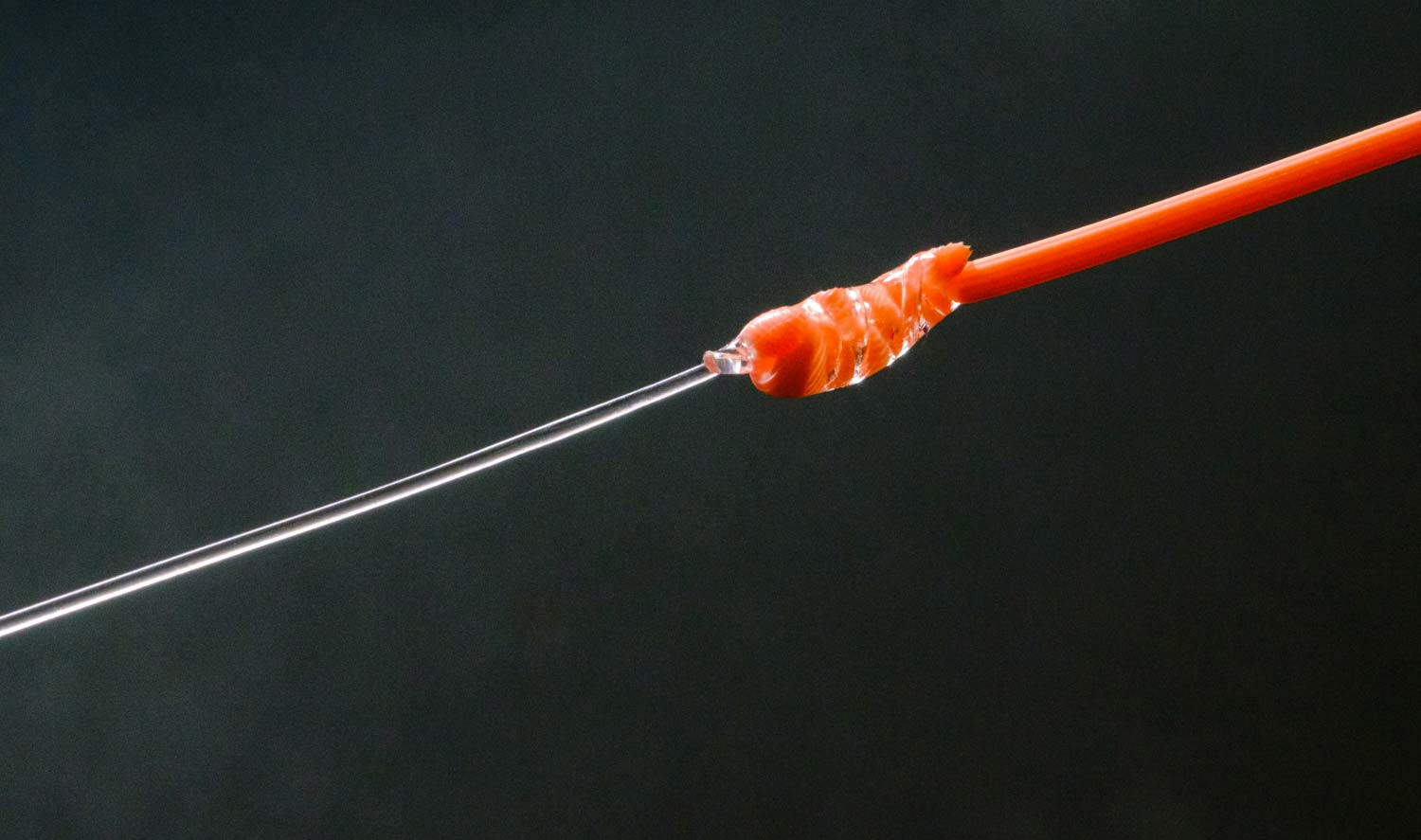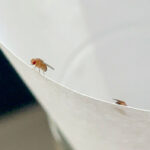Attaching a leader to your fly line is a fundamental skill in fly fishing. The connection you choose can significantly impact your fishing success. While there are several methods to achieve this, understanding the most reliable and effective techniques is crucial. This guide explores three popular knots for connecting your leader to your fly line, helping you choose the best approach for your fishing style and needs.
The Nail Knot: A Traditional Approach
 Louis Cahill demonstrating the Nail Knot for fly line and leader connection.
Louis Cahill demonstrating the Nail Knot for fly line and leader connection.
The Nail Knot is a time-honored method for joining a fly line and leader, revered for its smooth profile. For many seasoned anglers, particularly those who started fly fishing decades ago, the Nail Knot was the go-to technique. It functions by using friction to secure the leader to the fly line. Tying this knot requires some dexterity and is often made easier with the aid of a tool like a nail, a small diameter tube, a dedicated Nail Knot tool, or even hemostats, which many anglers already carry.
One of the primary advantages of the Nail Knot is its slim profile. When properly executed and perhaps coated with a thin layer of UV resin, it glides through rod guides with minimal friction. This streamlined quality is especially appreciated in Euro nymphing techniques where anglers frequently retrieve line up to the leader-fly line connection. However, the necessity of drawing the leader-fly line junction through the guides is debatable for many standard fly fishing scenarios and, in some opinions, may increase the risk of losing fish due to breakage. While the Nail Knot offers a sleek transition, its primary drawback lies in its relative weakness compared to other connection methods. The knot’s strength relies on gripping the fly line’s outer coating, which is inherently the most fragile part of the line. Stress on the connection can lead to the Nail Knot stripping this coating rather than the knot itself failing outright. For typical trout fishing scenarios using lighter tippets (like 5X), the Nail Knot’s strength is generally adequate. It will likely hold up better than the tippet itself. However, for more demanding situations such as streamer fishing or saltwater angling, the Nail Knot’s reliability becomes questionable.
Loop to Loop: Convenience and Strength Combined
In contemporary fly fishing, the loop-to-loop connection has become increasingly popular, favored for its blend of strength and ease of use. Many modern fly lines are manufactured with pre-welded loops at the tip, specifically designed for this type of leader attachment. Although some anglers, particularly those targeting larger, more powerful species or fishing in harsh conditions, may opt to create their own whipped loops for enhanced durability, the loop-to-loop system remains a highly efficient and robust method. Its convenience is particularly appealing to anglers who, like the original article’s author, frequently change leaders to adapt to varying fishing conditions or tactics. When employing a loop-to-loop connection, proper execution is vital. For self-made loops, whipping techniques enhance strength, especially for saltwater environments. Furthermore, selecting an appropriate loop knot for the leader side is crucial for overall connection integrity.
The key benefits of the loop-to-loop connection are its strength and the speed at which leaders can be changed. Experienced fly anglers often emphasize the importance of using fresh leaders, minimizing the risk of breakage due to weakened or damaged material. Moreover, the ability to quickly switch leaders allows anglers to efficiently adapt to changes in fly patterns, water conditions, or target species. While the loop-to-loop connection is incredibly practical, it’s acknowledged that it doesn’t pass through rod guides as seamlessly as a Nail Knot due to its slightly bulkier profile. A common misconception is that loop-to-loop connections create a “hinge point” that negatively affects casting or leader turnover. However, when properly tightened and constructed with a leader butt section of appropriate stiffness, this is largely unfounded. The “hinge point” issue is more often attributable to using leaders with excessively fine or supple butt sections, rather than the loop-to-loop connection itself. Testing the connection and leader setup will readily demonstrate its stability and performance.
The Albright Knot: A Versatile and Robust Option
The Albright Knot stands out as a highly versatile and robust knot choice for connecting leaders to fly lines, suitable for a wide spectrum of fly fishing applications. It effectively merges the advantages of both the Nail Knot and the loop-to-loop methods. The Albright Knot presents a relatively slim profile, similar to the Nail Knot, which aids in smoother passage through rod guides, especially when treated with UV resin. Simultaneously, when tied correctly, it offers a strength comparable to, and in some cases exceeding, that of a loop-to-loop connection, making it reliable even for demanding species like tarpon.
Beyond leader-to-fly line connections, the Albright Knot is exceptionally useful for joining lines of significantly different diameters or materials, expanding its utility in various rigging scenarios. This makes it a valuable knot to master for any angler. The primary downsides of the Albright Knot relate to leader changes and potential fly line wear. Changing leaders attached with an Albright Knot is less swift than with a loop-to-loop system. Each time a leader is replaced, a small section of the fly line tip is trimmed, potentially shortening the line over repeated leader changes. A workaround to mitigate these drawbacks involves using the Albright Knot to attach a short section of heavier leader material to the fly line. A loop can then be tied in the end of this heavier material, allowing for quick leader changes via a loop-to-loop connection. However, this essentially transitions the system back to a loop-to-loop approach at the leader attachment point. Furthermore, the Albright Knot is considered slightly more challenging to tie correctly than the Nail Knot or a simple loop knot. Improperly tied Albright Knots are prone to failure. Therefore, practicing and thoroughly testing Albright Knots is crucial to ensure a reliable connection in fishing situations.
Conclusion: Choosing the Right Connection for You
Each of these three methods – the Nail Knot, the Loop-to-Loop, and the Albright Knot – offers distinct advantages and disadvantages for connecting a leader to a fly line. The “best” method ultimately depends on individual preferences, fishing styles, and target species. Experimenting with and mastering all three techniques is highly recommended. Situations can arise on the water where one method proves more practical or necessary than another, such as needing to repair a damaged fly line tip and adapting the connection method on the fly, as illustrated in the original article’s anecdote of using an Albright Knot to replace a damaged loop. Having a repertoire of connection methods ensures preparedness and adaptability in diverse fishing scenarios.
What’s your preferred method for attaching a leader to your fly line? Share your experiences and insights in the comments below!
